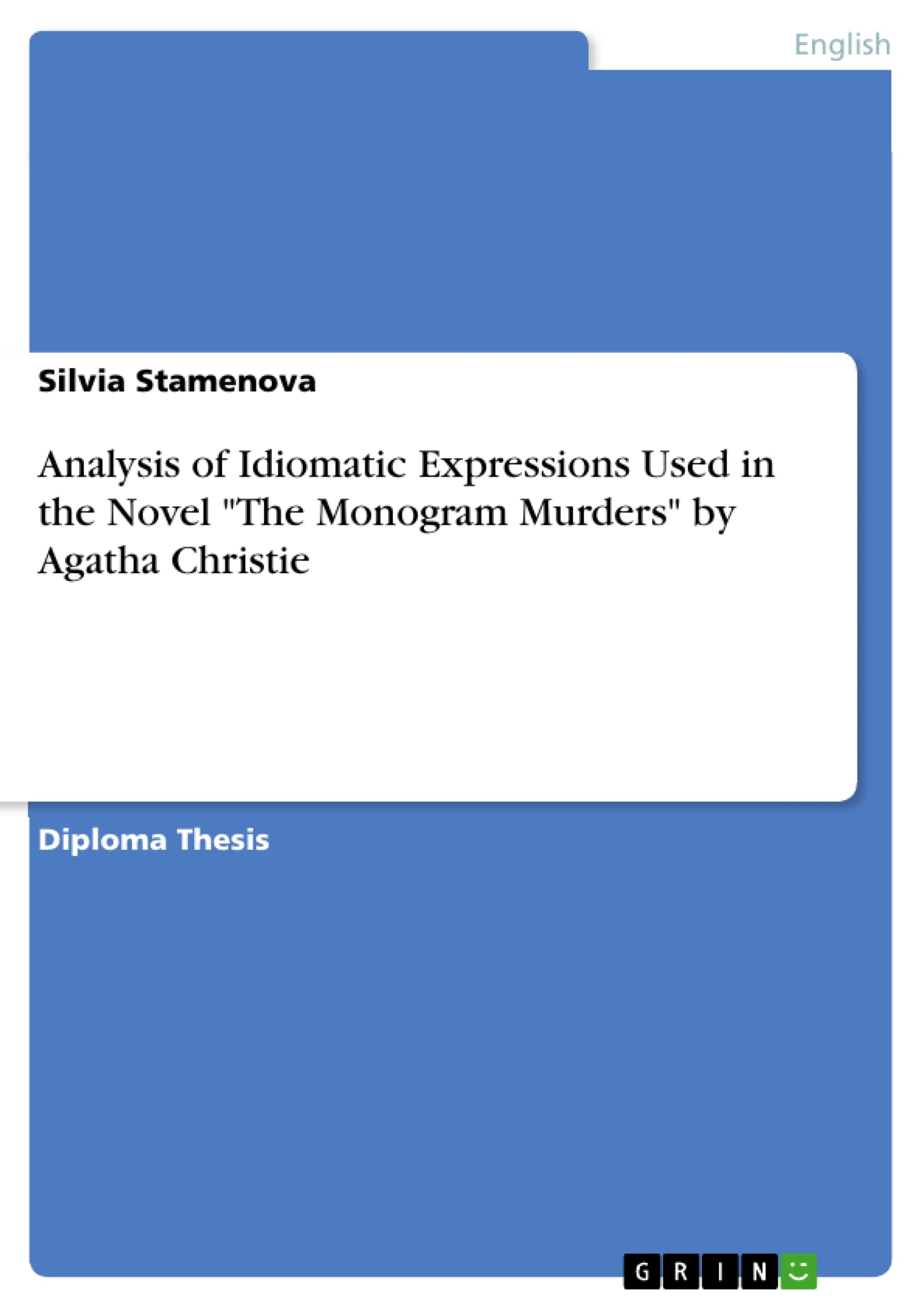The question posed in this thesis concerns the usage of idioms in the everyday language, as well as in the book “The Monogram Murders”. This paper, therefore, argues that in the non-literal language, some differences are obvious, and thus we can recognize an idiom quite easily. However, there are differences and divisibilities in the idioms themselves - some of them bear the meaning of their compounds while others are simply composed of words that cannot be used with their literal meaning, especially in the context of the idiom itself.
The language as a system of communication has both literal and often figurative meanings. However, in the historical grammaticism such a meaning was often used in order to give notions like metaphors, similes, proverbs and idioms. Most of them often carry a metaphorical sense that makes their comprehension difficult, as in fact their meaning cannot be inferred/guessed from the meaning of their constituent parts.
Taking all of the abovementioned into account, in the present thesis I will present the results of the research I have made based on the idiomatic usage in the novel of Agatha Christie “The Monogram Murders”. Due to the extensive length of my research, I will focus on the idioms that have made their impression on me and on their translation into Bulgarian.
The aim of this graduate thesis is to evaluate and describe the idiomatic expressions used in the novel “The Monogram Murders” by Agatha Christie. That kind of analysis is particularly interesting as it concerns the work of art of а famous writer that from а semantic point of view describes the ideas composing the whole book.
Inhaltsverzeichnis (Table of Contents)
- INTRODUCTION.
- CHAPTER ONE
- IDIOMS IN THE ENGLISH LANGUAGE
- 1.1 Idioms and Metaphors.
- 1.2 Idioms and Clichés.
- 1.3 Idioms and Proverbs.....
- 1.4 Idioms and Fixed Expressions.
- 1.5 Alterations of grammatical rules
- 1.6 Phrasal Verbs
- 1.7 Transparent - Opaque Idioms
- 1.8 Informal Idioms......
- 1.9 Formal Idioms...
- 1.10 Verbal Idioms
- 1.11 Idiomatic Pairs..
- 1.12 Idioms used in special field.
- 1.13 Idioms with Comparisons.
- CHAPTER TWO
- ANALYSIS ON THE IDIOMATIC EXPRESSIONS.
- 2.1 Research method
- 2.2 Idiomatic expressions used in the book \"The Monogram Murders\"
- 2.3 Phrasal Verb
- 2.4 Phrasal-Prepositional Verbs...........
- 2.5 Prepositional Phrase.....
- 2.6 Idioms with Verbs as Keywords...
- 2.7 Idioms with Nouns as Keywords.....
- 2.8 Idioms with Adjectives as Keywords.
- 2.9 Idiomatic Pairs……………………
- CHAPTER THREE
- SUMMARIZED IDIOMS AND COMPOUNDS.
- 3.1 Idioms from Chapter 1 of Agatha Christie novel, the Monogram Murders
- 3.2 Compounds From Chapter 1 of Agatha Christie novel, The Monogram Murders..............
Zielsetzung und Themenschwerpunkte (Objectives and Key Themes)
This graduate thesis aims to analyze and describe the use of idiomatic expressions within the novel “The Monogram Murders” by Agatha Christie. The research focuses on the specific vocabulary used in the novel, examining its semantic significance within the larger context of the story. The key themes of this work include:- The nature and classification of idioms in the English language.
- The analysis of idiomatic expressions used in the novel “The Monogram Murders”.
- Exploring the various types of idioms, including phrasal verbs, prepositional phrases, and idioms with different keywords.
- The significance of idioms in conveying meaning and context within literary works.
- The potential impact of idiomatic usage on the translation and comprehension of literary works.
Zusammenfassung der Kapitel (Chapter Summaries)
- Chapter One: This chapter provides a comprehensive overview of idioms in the English language. It explores the definition, classification, and different categories of idioms, including metaphors, clichés, proverbs, and fixed expressions. The chapter further examines the grammatical rules related to idioms, the distinction between transparent and opaque idioms, and the use of idioms in different contexts, including formal and informal settings.
- Chapter Two: This chapter focuses on the analysis of idiomatic expressions used in the novel “The Monogram Murders”. It outlines the research methodology employed and examines the various types of idioms found in the text, such as phrasal verbs, phrasal-prepositional verbs, prepositional phrases, and idioms with different keywords. The chapter also analyzes the use of idiomatic pairs within the novel.
- Chapter Three: This chapter presents a summary of the idioms and compounds identified in the first chapter of “The Monogram Murders”. It provides a comprehensive list of the idiomatic expressions found in the novel and analyzes their usage and significance within the story.
Schlüsselwörter (Keywords)
The research is focused on the analysis of idiomatic expressions and their role in conveying meaning and context within the novel “The Monogram Murders.” Key concepts explored in the thesis include the classification of idioms, the use of phrasal verbs, prepositional phrases, and idioms with different keywords, and the overall impact of idioms on the narrative and meaning of the literary work.- Citar trabajo
- Silvia Stamenova (Autor), 2016, Analysis of Idiomatic Expressions Used in the Novel "The Monogram Murders" by Agatha Christie, Múnich, GRIN Verlag, https://www.grin.com/document/426565



